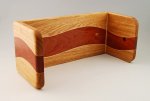Your pattern bit in the router will be, perhaps, 1/2 inch diameter. That means that the second side won't match the first. For a gross example, assume a box. Cut the inside with a pattern bit, and the inside will be 1/2 inch shorter on each side. With the curves, they simply won't fit tight. Unless you had a flexible 1/2 inch thick strip to fill the space taken by the bit.
If the curve is gradual, and the bandsaw blade is thin, you might get away with gluing the two pieces together directly. Or put in a flex contrast strip the thickness of the bandsaw blade (most of my blades are .035 with a kerf about .05, most veneer is about 1/42 or .024, so two layers of veneer would fill a bandsaw kerf).


